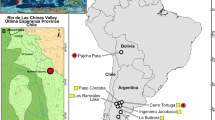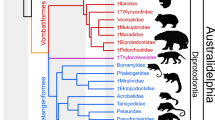Abstract
The oldest primates of modern aspect (primates of prosimian tarsiiform-lemuriform or higher grade) are known from Lower Eocene strata of Sparnacian age in Europe1,2, Bumbanian age in Asia3,4, and Wasatchian age in North America5. These first appearances coincide on all three northern continents with initial records of Artiodactyla, Perissodactyla and other modern mammalian groups appearing approximately 53 Myr BP6,7. Here I report that a newly discovered basal Wasatchian f aunal assemblage older than any known previously includes the well-preserved dental remains of a new species of Cantius, the earliest representative of Eocene Adapidae and the oldest evidence of primates of modern aspect known from North America. This new Cantius is possibly ancestral to all later adapids, including the European Donrussellia and North American Pelycodus. Cantius torresi has premolars reminiscent of those in Omomyidae, suggesting that earlier lemuriform and tarsiiform primates were closely related and little differentiated at the beginning of the Eocene.
This is a preview of subscription content, access via your institution
Access options
Subscribe to this journal
Receive 51 print issues and online access
$199.00 per year
only $3.90 per issue
Buy this article
- Purchase on Springer Link
- Instant access to full article PDF
Prices may be subject to local taxes which are calculated during checkout
Similar content being viewed by others
References
Godinot, M. C. r. hebd. Séanc. Acad. Sci., Paris D286, 1869–1872 (1978).
Hooker, J. J. & Insole, A. N. Tertiary Res., Rotterdam 3, 31–45 (1980).
Dashzeveg, D. & McKenna, M. C. Acta palaeont. pol. 22, 119–137 (1977).
Dashzeveg, D. Bull Soe. géol. Fr. Sér. 7 24, 275–281 (1982).
Rose, K. D. Science 208, 744–746 (1980).
Berggren, W. A., McKenna, M. C., Hardenbol, J. & Obradovich, J. D. J. Geol. 86, 67–81 (1978).
Harland, W. B. et al. A Geologic Time Scale (Cambridge University Press, 1982).
Simons, E. L. Bull Br. Must. nat. Hist., Geol. 7, 1–36 (1962).
Russell, D. E., Louis, P. & Savage, D. E. Univ. Calif. Publs geol. Sci. 73, 1–46 (1967).
Szalay, F. S. Folia Primatol 22, 116–133 (1974).
Gingerich, P. D. Folia Primatol 28, 60–80; 144–153 (1977); J. hum. Evol. 10, 345–374 (1981).
Godinot, M. Palaeovertebrata 10, 43–126 (1981); Geobios, Mém. Spéc. 6, 403–412 (1982).
Rose, K. D. & Krause, D. W. J. Mammal. 65, 721–726 (1984).
Russell, D. E. & Gingerich, P. D. C. r. hebd. Séanc. Acad. Sci, Paris D291, 621–624 (1980).
Bown, T. M., Folia Primatol 25, 62–72 (1976).
Szalay, F. S. Bull Am. Mus. nat. Hist. 156, 157–450 (1976).
Gingerich, P. D. & Simons, E. L. Contr. Mus. Paleont. Univ. Mich. 22, 245–279 (1977).
Gingerich, P. D. & Haskin, R. A. Contr. Mus. Paleont. Univ. Mich. 25, 327–337 (1981).
Rose, K. D. & Bown, T. M. Nature 309, 250–252 (1984).
Bown, T. M. & Rose, K. D. Folia Primatol 43, 97–112 (1984).
Buchardt, B. Nature 275, 121–123 (1978).
Kraus, M. J. in Early Cenozoic Paleontology and Stratigraphy of the Bighorn Basin, Wyoming (ed. Gingerich, P. D.) 87–94 (University of Michigan Museum of Paleontology, Ann Arbor, 1980).
Gingerich, P. D., Smith, B. H. & Rosenberg, K. Am. J. phys. Anthrop. 58, 81–100 (1982).
Rose, K. D. & Bown, T. M. J. Paleont. 58, 1532–1535 (1984).
Gingerich, P. D. Yb. phys. Anthrop. 27, 57–72 (1984).
Gingerich, P. D. in Prosimian Biology (eds Martin, R. D., Doyle, G. A. & Walker, A. C.) 531–541 (Duckworth, London, 1980).
Gingerich, P. D. in Major Topics in Primate and Human Evolution (eds Wood, B. A., Martin, L. B. & Andrews, P.) (Cambridge University Press, in the press).
MacPhee, R. D. E., Cartmill, M. & Gingerich, P. D. Nature 301, 509–511 (1983).
Gingerich, P. D. A. Rev. Earth planet. Sci. 8, 407–424 (1980).
Walker, A. C. in Prosimian Biology (eds Martin, R. D., Doyle, G. A. & Walker, A. C.) 435–447 (Duckworth, London, 1980).
Gingerich, P. D. Geobios, Mém. Spéc. 1, 165–182 (1977).
Simons, E. L. & Bown, T. M. Nature 313, 475–477 (1984).
McKenna, M. C. Ann. M. bot. Gdn 62, 335–353 (1975).
Smith, A. G. & Briden, J. C. Mesozoic and Cenozoic Paleocontinental Maps (Cambridge University Press, 1977).
Author information
Authors and Affiliations
Rights and permissions
About this article
Cite this article
Gingerich, P. Early Eocene Cantius torresi—oldest primate of modern aspect from North America. Nature 319, 319–321 (1986). https://doi.org/10.1038/319319a0
Received:
Accepted:
Issue Date:
DOI: https://doi.org/10.1038/319319a0
This article is cited by
-
Primates in the Eocene
Palaeobiodiversity and Palaeoenvironments (2012)
-
The labyrinthine morphology of Pronycticebus gaudryi (Primates, Adapiformes)
Palaeobiodiversity and Palaeoenvironments (2012)
-
A Palaeocene proboscidean from Morocco
Nature (1996)
Comments
By submitting a comment you agree to abide by our Terms and Community Guidelines. If you find something abusive or that does not comply with our terms or guidelines please flag it as inappropriate.



